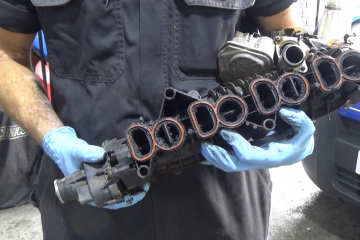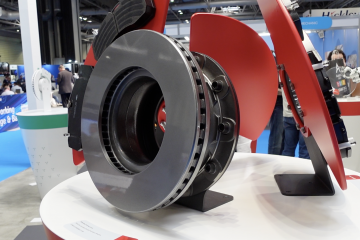The new car market in the UK started 2025 with a decline, the fourth month in succession that registrations figures have dropped.
In January, new-car deliveries declined 2.5%, with 139,345 units taking to the road, according to data from the SMMT. This is 3,531 units fewer than the same period in 2024.
The gap is down to a dramatic drop in petrol deliveries. Despite a strong performance from battery-electric vehicles (BEVs), and full hybrids (HEVs), the figures were not enough to prevent an overall market decline.
Despite being one of the most stable markets in Europe during the first seven months of 2024, the country has experienced a tumultuous time since August. Following the first registrations decline in two years, only September has seen improvement, thanks to the regular increase due to the ‘new-plate’ release.
The country has struggled with consumer confidence in recent months, while its zero-emission vehicle (ZEV) mandate has caused problems for carmakers. The SMMT also cited tough economic conditions as another factor in January’s decline.
Petrol struggles
Petrol car registrations have struggled since March 2024. This trend continued in January, with the fuel type down by 15.3%. This equated to 70,075 units, combining traditional petrol engines and petrol-powered mild hybrids (MHEVs). This combination with a growing MHEV market was not enough to prevent a 12,678-unit loss.
These results reflect both the changing attitudes towards the internal-combustion engine (ICE), and manufacturer preferences towards electrified models, especially with tougher ZEV mandate targets for 2025.
With a requirement that 28% of a carmaker’s fleet be made up of BEVs or hydrogen fuel-cell models, there may be a shift in availability of ICE units this year.
However, it appears clear that brands did not hold back petrol registrations at the end of 2024 to boost their ZEV registrations. Instead, changing attitudes towards the fuel type seem apparent.
Despite the decline, the third-heaviest for petrol registrations since April 2024, the fuel still led the market. The powertrain secured 50.3% of registrations, although this was down from 57.9% last year.
The diesel market also continued to shrink, with just 8,625 registrations, a fall of 7.7%. This meant 723 fewer units left dealerships in January, with the 6.2% market share dropping from 6.5% in January 2024.
BEV registrations increase
BEV registrations started 2025 strongly, with a 41.6% increase to 29,634 units. This meant 8,699 more units took to the road in the month.
January’s result was more than double the entire BEV registration figure for 2017, according to the SMMT, highlighting how far the technology has come. Yet despite being the second-most-popular fuel type in the market, it was still some way behind petrol.
BEVs secured a share of 21.3% in January. This was up by 6.6 percentage points year on year, but below the ZEV mandate threshold for last year. With this target increasing to 28% of ZEV sales in a carmaker’s fleet for 2025, there are challenges ahead for the technology.
BEV registrations will not be helped by the introduction of vehicle excise duty (VED), scheduled to come into effect from April. At this point, every new all-electric model registered will be required to pay the tax.
For the first year of registration, this will cost drivers just £10. After this, they will pay the standard annual rate of £195. Drivers of BEVs sold since April 2017 will also be required to pay the higher annual rate.
Expensive car supplement
But for BEVs that cost more than £40,000, drivers will have to pay the Expensive Car Supplement (ECS). This is added to the VED rate for five years from the second year of registration. This could mean drivers would pay an additional £410 on top of the VED duty for five years.
“Affordability remains a major barrier to uptake, hence the need for compelling measures to boost demand, and not just from manufacturers. The application, therefore, of the Expensive Car Supplement to VED on electric vehicles is the wrong measure at the wrong time,” commented SMMT chief executive Mike Hawes.
“Rather than penalising EV buyers, we should be taking every step to encourage more drivers to make the switch, helping meet government, industry and societal climate change goals.”
The ECS threshold has not been amended since the additional tax was introduced eight years ago. Since then, the BEV market has grown. With several popular models exceeding the £40,000 limit, the introduction of VED with the ECS could impact their desirability.
The ECS will not apply to vehicles already on the road, however. This could mean that the used-car market for BEVs will boom in 2025, with drivers wanting an all-electric model turning to older units to bypass the supplement. With any increase of activity in the used-car market, there is a likelihood that independent workshops will see more work.
This means it is likely that, together with more BEVs hitting three-years-old in 2025, the number of BEVs entering workshops for servicing and repair will rise, meaning garages need to be ready to accept them.
The SMMT is calling on the UK Government to raise the eligibility threshold for all-electric models, or exempt them entirely from the Expensive Car Supplement. The body argues that this would send the message that EVs are essentials, not luxuries, and ensure vehicle taxation remains fair and appropriate for today’s market conditions.
Hybrid highs
Registrations of HEVs improved by 2.9% in January, as 18,413 units took to UK roads. This was an increase of 517 deliveries compared to the same period last year.
This growth meant that HEVs took a 13.2% share of the market, up from 12.5% in January 2024. The powertrain remained the UK’s third-most-popular technology in the month.
Plug-in hybrids (PHEVs) saw growth of 5.5% at the start of the year, with 12,598 deliveries, up by 654 units. This gave the powertrain a 9% market share, up 0.4 percentage points year on year.
The PHEV result meant that electric vehicle registrations grew 28.4% in January, with a 30.3% share. The market for electrified vehicles, including HEV, BEVs and PHEVs, improved 19.4%. However, the additional 9,870 units was not enough to offset the ICE deficit of 13,401 passenger cars, representing a total 14.6% drop.
Market decline expected
With a difficult start to the year, the UK market must hope to build back up in 2025, especially in the second half.
However, the latest market outlook from the SMMT suggests that registrations will decline slightly, by 0.2%, across the full year. With this forecast, around 1.95 million units will be delivered to customers.
BEV uptake is expected to improve by 20.9% to 462,000 units, a 23.7% market share. This will be far short of the mandated 28% target for 2025. The gap is anticipated to widen in 2026, when BEVs are expected to comprise 28.3% against a target of 33%.
Therefore, the SMMT believes that market incentives are required, to boost the uptake of BEVs.



